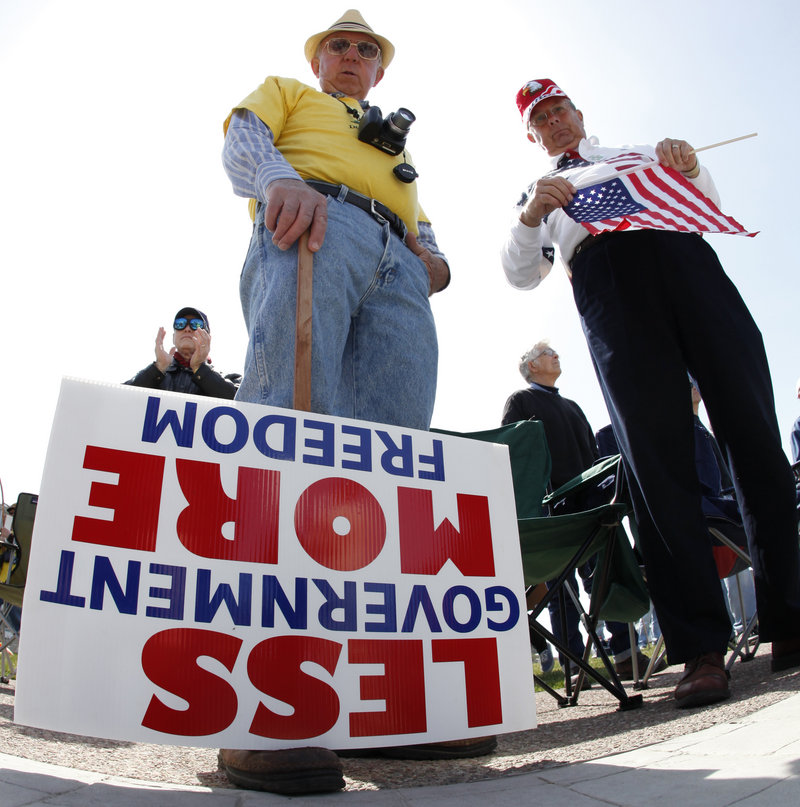In an unruly, unpredictable and chaotic election year, no group has asserted its presence and demanded to be heard more forcefully than the tea party.
The grass-roots movement that was spawned with a rant has gone on to upend the existing political order, reshaping the debate in Washington, defeating some prominent lawmakers and elevating a fresh cast of conservative stars.
But a new Washington Post canvass of hundreds of local tea party groups reveals a different sort of organization, one that is not so much a movement as a disparate band of vaguely connected gatherings that do surprisingly little to engage in the political process.
The results come from a months-long effort by The Post to contact every tea party group in the nation, an unprecedented attempt to understand the network of individuals and organizations at the heart of the nascent movement.
Seventy percent of the grass-roots groups said they have not participated in any political campaigning this year. As a whole, they have no official candidate slates, have not rallied behind any particular national leader, have little money on hand, and remain ambivalent about the political process in general.
“We’re not wanting to be a third party,” said Matt Ney, 55, the owner of a pilates studio and a founder of the Pearland Tea Party Patriots in Pearland, Tex. “We’re not wanting to endorse individual candidates ever. What we’re trying to do is be activists by pushing a conservative idea.”
The group, with 25 active members, meets to discuss policies and listen to speakers, Ney said. “We provide opportunities for like-minded people to get together,” he said.
The local groups stand in contrast to — and, in their minds, apart from — a handful of large national groups that claim the tea party label. Most of those outfits, including FreedomWorks and Tea Party Express, are headed by longtime political players who have used their resources and know-how to help elect a number of candidates.
The findings suggest that the breadth of the tea party may be inflated. The Atlanta-based Tea Party Patriots, for example, says it has a listing of more than 2,300 local groups, but The Post was unable to identify anywhere near that many, despite help from the organization and independent research.
In all, The Post identified more than 1,400 possible groups and was able to verify and reach 647 of them. Each answered a lengthy questionnaire about their beliefs, members and goals. The Post tried calling the others as many as six times. It is unclear whether they are just hard to reach or don’t exist.
Mark Meckler, a founding member of the Tea Party Patriots, said: “When a group lists themselves on our website, that’s a group. it could come in and out of existence — we don’t know. We have groups that I know are 15,000 people, and I have groups that I know are five people.”
There is little agreement among the leaders of various groups about what issue the tea party should be most concerned about. In fact, few saw themselves as part of a coordinated effort.
The most common responses were concerns about spending and limiting the size of government, but together those were named by less than half the groups. Social issues, such as gay marriage and abortion rights, did not register as concerns.
If anything tied the groups together, it was what motivated their members to participate. Virtually all said that economic concerns were a factor, and nearly as many cited a general mistrust of government. Opposition to President Obama and Democratic policies was a big factor, but only slightly more so than dissatisfaction with mainstream Republican leaders.
Eleven percent said that Obama’s race, religion or ethnic background was either a “very important” or “somewhat important” factor in the support their group has received.
The tea party’s biggest successes this year have come only after one of a handful of well-funded national groups swooped in to mobilize local support. In upset victories in Alaska and Delaware, for instance, the Sacramento-based Tea Party Express spent hundreds of thousands of dollars for Republican Senate candidates Joe Miller and Christine O’Donnell, respectively.
Many organizers said the independence of local groups is what drew them to the movement, even if it is a liability when it comes to turning their beliefs into action.
“It’s both an advantage and a disadvantage,” said Joe Lisante, 43, a family doctor and a founder of Miami County Liberty, a group near Dayton, Ohio.
“If you’re an opponent of the tea party, we’re not an easy target,” he said. “Some of the groups want to take on prayer in school. Some of them want to take on voter education. Some want to be endorsing candidates. But there is no particular person, at least in the state of Ohio, who is the president of the tea party; it just doesn’t exist.
“That’s a disadvantage for us because we can’t move quickly on things. We can’t always agree.”
Send questions/comments to the editors.



Success. Please wait for the page to reload. If the page does not reload within 5 seconds, please refresh the page.
Enter your email and password to access comments.
Hi, to comment on stories you must . This profile is in addition to your subscription and website login.
Already have a commenting profile? .
Invalid username/password.
Please check your email to confirm and complete your registration.
Only subscribers are eligible to post comments. Please subscribe or login first for digital access. Here’s why.
Use the form below to reset your password. When you've submitted your account email, we will send an email with a reset code.